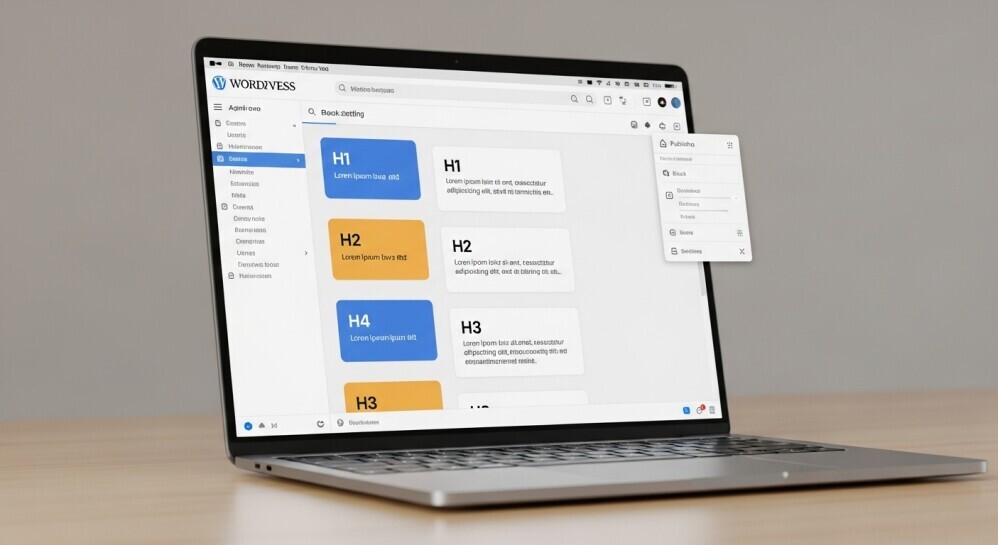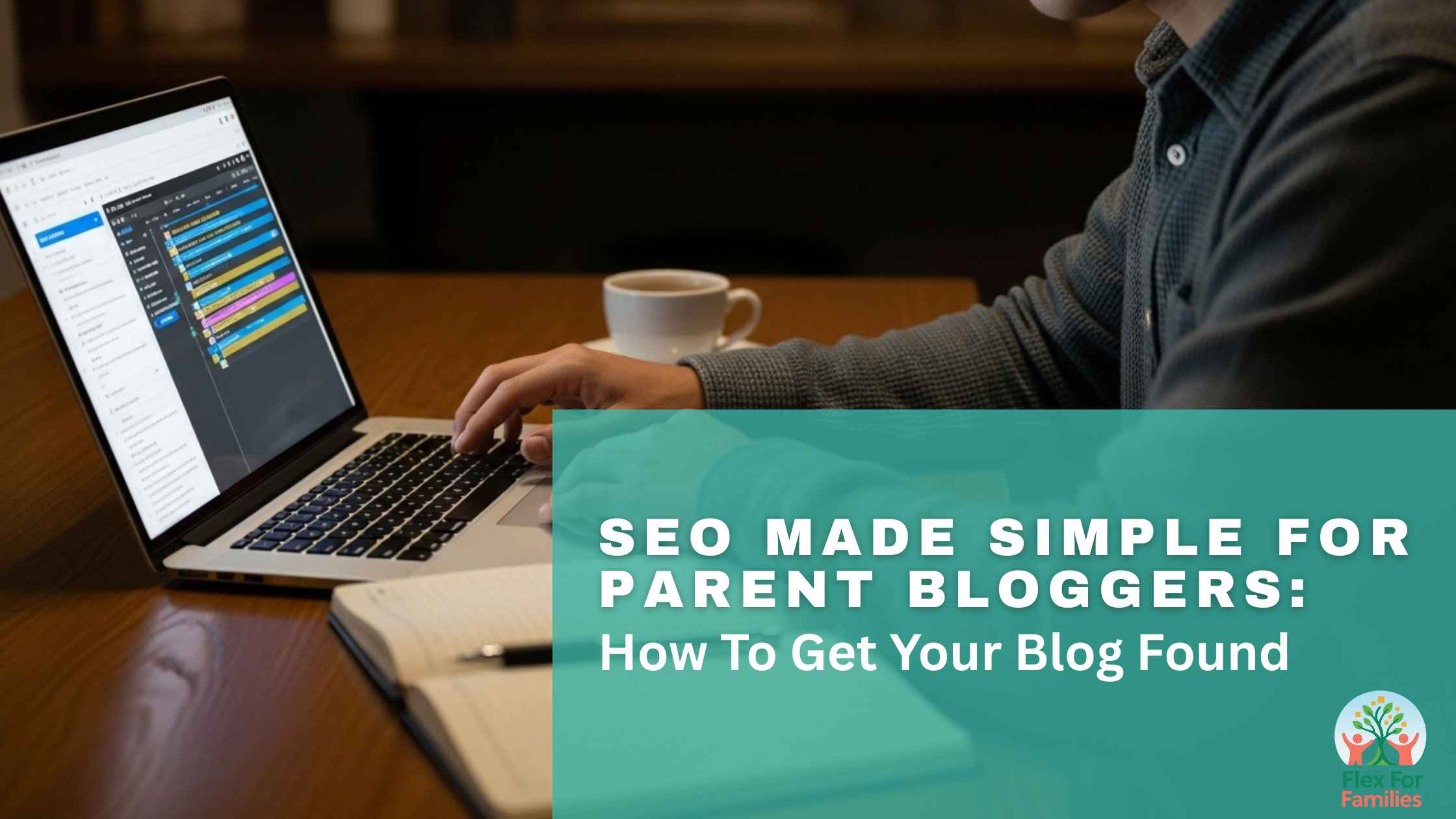Why SEO Doesn’t Have to Be Scary
SEO (search engine optimisation) sounds complicated, but at its core, it’s simple. It’s just helping the right people find your blog when they search for something you already write about.
If you’ve ever googled “quick breakfast ideas for toddlers” or “how to get kids to sleep through the night,” you’ve used SEO. When your posts answer those kinds of questions, search engines push them toward the top so that other parents can find them too.

The trick isn’t learning code or buying fancy tools. It’s learning how to speak the same language your readers use when they type their problems into Google. Once you understand that, SEO becomes much less about algorithms and much more about connection.
Think of SEO as a quiet way to build trust… You’re showing up right when another parent needs your help.
If you haven’t already read How to Write Blog Posts That Connect and Keep Parents Coming Back, start there first. It’ll help you focus on writing content that feels natural before layering in SEO.
Every parent blog starts somewhere. Here’s your roadmap through the Parent Blogging Success series — from your first post to building income that fits your family.
Step 1: Start With Topics Parents Actually Search For
The first step to getting found is simple – write about what parents are already looking for.
When a post solves a real problem, it has a much better chance of showing up in search results. Start by thinking about the questions you’ve typed into Google during tough parenting moments. Those same questions are what other parents are asking, too.

Here’s how to find topics easily:
- Use Google’s search bar. Type your topic and look at the “People also ask” section. Those are real questions people type in.
- Try free tools like Ubersuggest or Jaaxy. They show related keywords and how often they’re searched.
- Check Pinterest. It’s a search engine too, and great for spotting trending topics among parents.
Keep a running list of topics that feel both useful and natural for you to write about. If you see overlap between your own experiences and what’s being searched for, that’s your sweet spot.
The best SEO strategy starts with empathy, not algorithms.
If you’re still fine-tuning your blog’s direction, my post Parenting Blog Niche Ideas: Find Your Voice and Connect With the Right Readers will help you focus on the right audience before chasing keywords.
Step 2: Use Keywords Naturally in Your Posts
Once you’ve found a topic parents are searching for, it’s time to weave those keywords into your writing… But without overthinking it.
The biggest mistake new bloggers make is stuffing keywords everywhere. That doesn’t help search engines or readers. What does help is writing naturally and placing keywords where they make sense.

Here’s the simple way to do it:
- Title: Include your main keyword once near the beginning.
- Intro paragraph: Use it again naturally as you set up the topic.
- Headings (H2 or H3): Add variations where it feels natural.
- Conclusion: Repeat it once to wrap things up.
That’s it. No formulas, no keyword counting.
If your post reads smoothly out loud, you’ve done it right. SEO works best when your readers – not the algorithm – understand your message.
I usually write in Google Docs or the Wealthy Affiliate SiteContent editor because both help me focus on words first, not formatting. You can easily check keyword placement later, before publishing.
Step 3: Optimise Your Blog Post Layout
Search engines don’t just read your words. They look at how your post is structured. A clean, easy-to-follow layout helps both your readers and Google understand what your post is about.

Here’s what to focus on:
- Title tag: Keep it clear, under 70 characters, and include your keyword.
- Meta description: One or two sentences summarising your post with a natural keyword mention.
- Headings: Break up sections using H2 and H3 tags – this helps Google see your post’s main topics.
- Internal links: Link to other relevant posts on your site to keep readers exploring (and build SEO strength).
- Alt text on images: Add short, descriptive phrases to every image – like “parent writing blog at kitchen table.”
These small steps make your content easier to find, read, and understand – without any technical setup.
If you want a beginner-friendly walkthrough, Wealthy Affiliate’s SEO training covers all of this inside its free lessons. It’s where I first learned how to apply SEO without feeling overwhelmed.
For help with formatting and visuals, see The Best Blogging Tools for Parents Who Want Simplicity and Sanity. It includes design and layout tools that make posts look clean and professional without spending hours tweaking details.
Step 4: Use Internal Links to Guide Readers
Internal links are simply connections between your own blog posts. They help readers find more of your content and show Google that your site is trustworthy and well-organised.
Think of them as little pathways through your blog. When a reader finishes one post, a quick link to another keeps them exploring, and that extra time on your site tells search engines your content is worth recommending.

Here’s how to use them:
- Link naturally. Add links where they make sense in conversation, not as a list.
- Use clear anchor text. Instead of “click here,” use phrases like “learn how to build your blogging routine.”
- Link to older posts often. Keep your evergreen content alive by referencing it in new posts.
- Don’t overdo it. Two or three internal links per post is plenty.
Here’s a real example.
If you’re learning how to keep your blogging rhythm steady, link to How to Build a Simple Blogging Routine That Fits Family Life.
Or if you’re writing about helping readers connect through stories, link to How to Write Blog Posts That Connect and Keep Parents Coming Back.
Internal links guide readers smoothly from one useful post to the next. Helping both them and your SEO.
Step 5: Create Posts That Keep Readers on Your Blog
Getting people to your blog is only half the job. Keeping them there is where SEO really starts to work.
Search engines track how long visitors stay on your site. And the longer they read, the better your chances of ranking higher. But you don’t have to trick anyone into staying. You just need to create posts that genuinely hold their attention.

Here’s how to do it:
- Start strong. Use your first paragraph to speak directly to your reader’s problem or question.
- Add visuals. A quick Canva image, checklist, or quote graphic helps break up text and keep readers scrolling.
- Use short paragraphs. Keep things easy to scan on phones and tablets.
- End with a question or next step. Invite readers to comment, share, or read a related post.
You can also add “Let’s Chat” sections or gentle calls to action to help readers feel involved. When your content feels like a conversation, people naturally stay longer.
If you’d like templates and post structures that make this easier, they’re all inside the Parent Blogging Hub – built specifically to help parents create content that connects and ranks.
Step 6: Be Patient! SEO Takes Time, Not Tricks
Here’s the truth most people skip over: SEO isn’t instant.
You can do everything right: find the perfect keywords, optimise your layout, write from the heart. And it can still take a few months to see results. That’s normal.

Search engines reward consistency. Every time you publish a helpful, clear post, you’re building authority. Over time, those posts start to rise together.
What matters most is showing up. Keep writing, keep linking, and keep improving. Small efforts each week compound into steady, long-term growth.
If you want to make SEO part of your regular rhythm, read How to Build a Simple Blogging Routine That Fits Family Life. It’ll help you blend consistency and calm so you can stay on track without burnout.
Common Questions: FAQ

How long does it take to see SEO results?
Usually, three to six months for newer blogs, depending on how often you post.
It’s a slow build, but one that pays off long term.
Do I need plugins or paid tools?
Not at the start. Free tools like Google Analytics, Google Search Console, Jaaxy, and Ubersuggest give you everything you need to track and improve your SEO.
What if I don’t understand analytics?
That’s okay. Focus on writing good posts first. Analytics simply show what’s already working. As you gain experience, you’ll learn to spot patterns – like which topics or keywords bring the most readers.
Can SEO work for small parenting blogs?
Absolutely. SEO rewards quality and consistency, not size. If you create genuine, helpful content, your blog can rank even against bigger sites.
Conclusion: Focus on Connection, Not Algorithms
At its heart, SEO is about connection. Helping parents find your words when they need them most.
You don’t need to chase trends or master every setting. You just need to keep showing up with valuable, honest posts that answer real questions.

When you combine consistency, compassion, and the right tools, your blog will grow naturally. And the best part? It’ll grow with you. At a pace that fits your family life.
If you’d like SEO templates, beginner checklists, and support from other parent bloggers learning the same thing, the Parent Blogging Hub is the perfect place to start.
Let’s Chat
What’s one part of SEO that’s always confused you? Keywords, links, or analytics?
Drop your question below. I read every comment and might turn the most common ones into future posts for the community.
Your feedback helps other parents learn, too, and that’s what this blog is all about.




